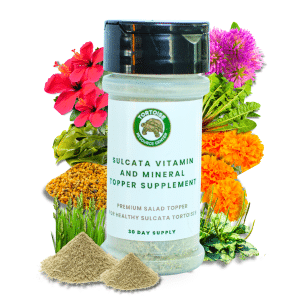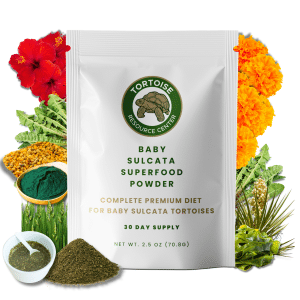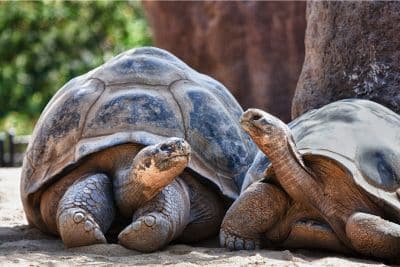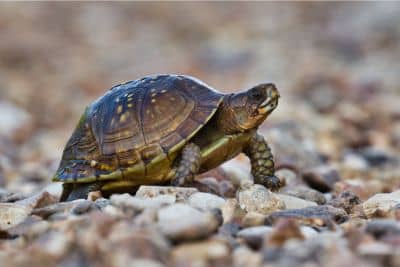Unusual geographic locations tend to produce unusual animals. And this is especially true of islands.
Take Madagascar, for example. The world’s fourth-largest island, it is home to a litany of spectacular animals, ranging from colorful panther chameleons (Furcifer pardalis) to the aye-aye (Daubentonia madagascariensis) – a truly one-of-a-kind lemur that’s found nowhere else.
But Madagascar is also home to a handful of tortoise species, including the small and attractive spider tortoise (Pyxis arachnoides). Rare in the wild and even rarer in captivity, the spider tortoise exhibits a number of features that make it one of the favorites of tortoise enthusiasts everywhere.
I’m now going to share some of the most important facts and stats about these amazing animals, so that you can decide if it would be a good species for you to keep (assuming you can find one).
Geographic Range
A Madagascar endemic, spider tortoises are only found in a narrow strip of land along the southwestern coast of the island. In the northern reaches of this range, the spider tortoise inhabits forested areas, but those individuals living in the southern portion of the range live in drier regions characterized by xerophytic, spiny vegetation.
There are actually three recognized subspecies of the spider tortoise, which inhabit different portions of the species’ range:
- The northern spider tortoise (P. a. bygooi) inhabits the northern portion of the species’ range.
- The common spider tortoise (P. a. arachnoides) is found in the middle of the species’ range.
- The southern spider tortoise (P. a. bygooi) lives near the southern tip of Madagascar.

Appearance and Physical Characteristics
Spider tortoises are one of the smaller species, and rarely exceed 6 inches in length. They have round, dome-shaped shells, which feature an intricate combination of yellow and dark colored markings, which are often likened to the appearance of a spider’s web (hence their common name).
All three subspecies of the spider tortoise are similar looking. Distinguishing between them generally requires the examination of plastral markings and the presence or absence of a hinge. The northern and common spider tortoise both possess a plastral hinge, while the southern spider tortoise does not.
Diet
Spider tortoises appear to be rather opportunistic and consume whatever food is available. Vegetation – especially succulent plants, dead leaves, and fallen fruit — appear to be important food sources. However, they’ve also been known to consume cactus fruit and pads, as well as dead animals they encounter.
There is even one report of spider tortoises consuming cow dung and the insects that could be found inside.
Behaviour
Like most other tortoise species, spider tortoises are typically most active in the morning. They’ll emerge from their overnight locations to find food, water, or mates.
Spider tortoises exhibit a strongly seasonal activity pattern. They spend the bulk of the dry season brumating while tucked away in burrows, under thick piles of leaf litter, or amid the roots of trees. When the rains return, the tortoises become active again and start eating and mating.
Spider tortoises have a very slow reproductive rate (which is part of the reason they’re so rare in captivity). Most individuals take about 10 to 12 years to reach maturity, and females produce clutches consisting of only a single egg. However, females may produce multiple clutches in each season.
The incubation period for spider tortoise eggs lasts quite a long time, and most eggs require 220 to 250 days to complete their development and hatch. The eggs – like the eggs of many other Madagascan reptiles – undergo something called “diapause,” characterized by a temporary cessation of development.
Spider Tortoise Stats at a Glance
Below, we’ll provide some of the most important stats concerning spider tortoises. This may help you decide if you are capable of properly caring for this species.
- Typical Hatchling Length: 1.25 inches
- Typical Hatchling Weight: Unclear, but likely 30 to 50 grams
- Average Adult Length: 6 inches
- Average Adult Weight: 0.7 to 1.5 pounds
- Maximum Adult Length: 8 inches
- Maximum Adult Weight: Unclear, but likely about 2 pounds
- Average Annual Fecundity: 1 to 3 eggs
- Recommended Enclosure Size: 10 to 12 square feet
- Typical Lifespan: Unclear, but these tortoises are thought to be capable of living for at least 70 years and potentially longer.
Do Spider Tortoises Make Good Pets?
Spider tortoises are generally not considered an ideal pet for beginning tortoise keepers. There are a variety of reasons for this, including their rarity – only a handful are produced each year (these tortoises are protected by international law, so wild-caught animals are absent from the legal pet trade).
Additionally, while these tortoises are generally easy to house and feed, they require a brumation period each year. This makes them more challenging to keep than some other species, such as red-footed tortoises (Chelonoidis carbonarius).
Are You Starving Your Tortoise?
Save 10% on premium tortoise food and supplements from Tortoise Resource Center on Amazon now using code BUYNOWGET10

Sulcata Vitamin & Mineral Topper Supplement
30-Day Supply | 2 oz (56 g)
$24.99

Baby Sulcata Tortoise Superfood Powder
30-Day Supply | 2.5 oz (70.8 g) Bag
$24.99
Citations
- Smithsonian’s National Zoo & Conservation Biology Institute – Spider Tortoise
- Reptiles Magazine – Spider Tortoise Care and Breeding
- The Turtle Room – Common Spider Tortoise


